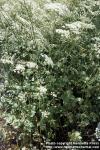 r
Latin name: Pimpinella anisum, aniseed, the plant covered here.
r
Latin name: Pimpinella anisum, aniseed, the plant covered here.
Illicium anisatum (I. verum), star anise, is a half-tropical bush, and not found in your usual temperate herb gardens; this one is not covered here.
2.26.1 Growing aniseed
From Jennifer A. Cabbage <fxjac.camelot.acf-lab.alaska.edu>:
Anise is an annual herb native to the Mediterranean- Egypt, Greece, Crete, and Asia Minor. It is a rather fussy herb; it likes perfect weather of uniform rainfall and temperatures. It wilts under excessive heat but requires full sun, and it does not transplant well.
Propagation is by seed, and be sure the seed is fresh. Seeds need a temperature of 70F to germinate, and will germinate in 7 to 14 days. Sow ¼ to ½ inch deep in light, well-drained, medium-rich sandy soil. A pH of 6.0 to 7.5 is best. Space 3 inch seedlings 6 to 12 inches apart.
2.26.2 Harvesting anise
From Jennifer A. Cabbage <fxjac.camelot.acf-lab.alaska.edu>:
Harvest seeds as soon as the tip of the seed turns gray (they should not be black), anywhere from 60 to 130 days after planting, depending on climate. Since Anise is an annual, collect seeds either by pulling up the entire plant, or by just cutting the tops off. Spread plants to dry. Thresh.
2.26.3 Using / preserving anise
From Jennifer A. Cabbage <fxjac.
camelot.acf-lab.alaska.edu>:
Use fresh leaves as a garnish or flavoring for salads. They can be cooked as a pot-herb.
Flowers are occasionally dried and powdered as a flavoring for wine.
Seeds are used in bread, pastries, cookies, vegetables, baked apples, applesauce, cheese, desserts, plum jam, brandy, cordials, and milk. ½ to 1 tsp per 4 quarts of potato or lentil soup, ½ tsp crushed in salads.
Use ground anise seed quickly, it loses its strength fast.

